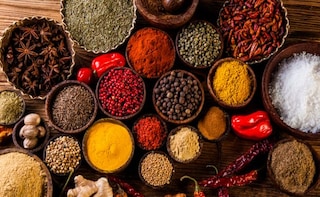Europe, in the Middle Ages, was enamoured with the East, which was exotic and alluring. And spices had a lot to do with it. The chase for spices did fan a lot of competition between the French, the English and the Dutch to gain control of trade and politics in the Indian Subcontinent. It will not be an exaggeration to say that spices were one of the reasons that Europeans began colonising parts of India.My experience and training in Western cuisine tells me that most of it relies on pairing ingredients that share similar flavour compounds. On the other hand, what makes Indian food so flavourful is the practice of bringing together lots of different ingredients with completely different flavours.
Aubergine/ 1 large
Cumin seeds or cumin powder from freshly roasted seeds 1 tsp
Creme Fraiche 120gms
Chopped Parsley 150gms
English Carrots 2 small ones
Shallots 1 large
Coriander Seeds 1 tsp
White Wine Vinegar 30ml
Turmeric tsp
Castor Sugar 60gms approx.
Garlic Puree: A tad bitMethod: Roast the aubergines in an oven. Rest. Mash and mix in with the Creme Fraiche. Add just a hint of garlic puree, salt and fresh cumin powder. Put in a piping bag and chill. Sear the tuna and let it rest. Roll in chopped parsley. Wrap tightly in a cling film and refrigerate. Whisk the vinegar, water, sugar, coriander seeds and turmeric in a bowl. Place in a pan and bring to a boil. Pour over the sliced carrots and shallots. Allow to cool at room temperature. Refrigerate.To serve: Pipe the aubergine Creme Fraiche on a plate. Place slices of tuna over it. Place pickled carrots around and pour a little pickle juice on top of the tuna. Serve chilled with coriander crisp or cress.
About Chef Ashay Dhopatkar:Chef Ashay Dhopatkar is Executive Chef at A Ta Maison, Private Members Club in New Delhi. He has trained with Chefs such as Herbert Berger, Raymond Blanc, Shane Osborne, Tom Hempstead and Gordon Ramsay. His own culinary style is a blend of Modern European cuisine, with British notes, using classical French techniques.
Advertisement
Advertisement
Cinnamon:While British dishes employ cinnamon in their interpretations of Indian dishes such as kebabs, the spice is mostly used to add flavour while baking or to flavour hot drinks such as coffee or hot chocolate. The warm sweet flavour makes it a popular ingredient in Western food, especially desserts (think Apple Pie).
Advertisement
Advertisement
Aubergine/ 1 large
Cumin seeds or cumin powder from freshly roasted seeds 1 tsp
Creme Fraiche 120gms
Chopped Parsley 150gms
English Carrots 2 small ones
Shallots 1 large
Coriander Seeds 1 tsp
White Wine Vinegar 30ml
Turmeric tsp
Castor Sugar 60gms approx.
Garlic Puree: A tad bitMethod: Roast the aubergines in an oven. Rest. Mash and mix in with the Creme Fraiche. Add just a hint of garlic puree, salt and fresh cumin powder. Put in a piping bag and chill. Sear the tuna and let it rest. Roll in chopped parsley. Wrap tightly in a cling film and refrigerate. Whisk the vinegar, water, sugar, coriander seeds and turmeric in a bowl. Place in a pan and bring to a boil. Pour over the sliced carrots and shallots. Allow to cool at room temperature. Refrigerate.To serve: Pipe the aubergine Creme Fraiche on a plate. Place slices of tuna over it. Place pickled carrots around and pour a little pickle juice on top of the tuna. Serve chilled with coriander crisp or cress.
About Chef Ashay Dhopatkar:Chef Ashay Dhopatkar is Executive Chef at A Ta Maison, Private Members Club in New Delhi. He has trained with Chefs such as Herbert Berger, Raymond Blanc, Shane Osborne, Tom Hempstead and Gordon Ramsay. His own culinary style is a blend of Modern European cuisine, with British notes, using classical French techniques.
For the latest food news, health tips and recipes, like us on Facebook or follow us on Twitter and YouTube.
Advertisement
